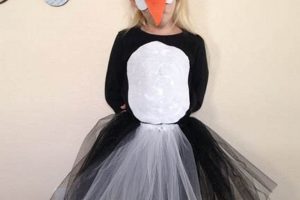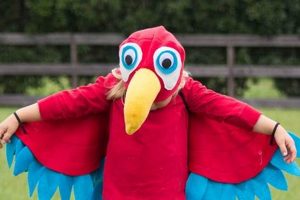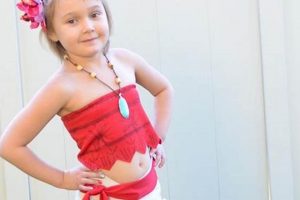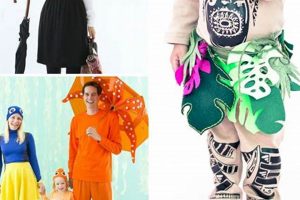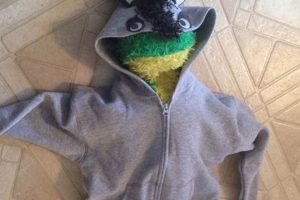Homemade attire for babies’ Halloween celebrations offers personalized and often budget-friendly alternatives to store-bought options. These ensembles range from simple adaptations of existing clothing to more elaborate creations using craft supplies and basic sewing techniques. An example includes transforming a white onesie into a ghost costume by adding felt eyes and a mouth.
The practice of creating these outfits allows for a unique expression of creativity and can result in costumes tailored specifically to an infant’s personality or interests. Furthermore, this approach often proves to be more economical than purchasing commercially produced costumes. The history of crafting Halloween apparel extends back to the holiday’s origins, with homemade options remaining a consistent element of its celebration.
The following sections will delve into various considerations and practical tips for developing safe, comfortable, and visually appealing homemade outfits for the youngest Halloween participants, including material selection, design considerations, and construction techniques.
Guidance for Crafting Infant Halloween Attire
The following outlines crucial considerations for safely and effectively designing and constructing infant Halloween attire. Attention to detail during the planning and execution stages is essential for ensuring the well-being and comfort of the infant.
Tip 1: Prioritize Safety: Select non-toxic and flame-retardant materials. Avoid small embellishments, such as buttons or beads, that could pose a choking hazard. Securely attach all components to prevent detachment.
Tip 2: Ensure Comfort: Choose soft, breathable fabrics like cotton or fleece to minimize skin irritation. Consider the weather conditions and select materials appropriate for both indoor and outdoor environments. Avoid restrictive designs that might impede movement.
Tip 3: Simplify the Design: Opt for straightforward designs that are easy to put on and take off. Complex constructions may cause discomfort for the infant and increase the risk of overheating.
Tip 4: Consider Functionality: Design the attire to accommodate diaper changes easily. Ensure that the outfit does not obstruct the infant’s vision, breathing, or ability to move freely.
Tip 5: Accurate Sizing: Consult accurate size charts and measure the infant carefully to ensure a proper fit. Avoid overly tight or loose garments, as these can be uncomfortable or pose a safety risk.
Tip 6: Test Beforehand: Conduct a trial run before Halloween to observe the infant’s reaction to the attire. This allows for necessary adjustments to ensure comfort and safety.
Tip 7: Minimize Restraints: Reduce the use of elastic bands or ties around the infant’s extremities. If used, ensure they are loose enough to avoid restricting circulation.
Careful planning and execution are crucial for ensuring that homemade Halloween apparel is safe, comfortable, and age-appropriate. The aforementioned considerations serve to enhance the infant’s experience and contribute to a positive Halloween celebration.
The next section will address specific design concepts and offer practical examples for executing these considerations.
1. Safety Standards
The creation of homemade Halloween attire for infants necessitates adherence to stringent safety standards. The infant’s vulnerability necessitates careful consideration of potential hazards often overlooked in mass-produced costumes designed for older children or adults. Failure to comply with relevant safety guidelines directly increases the risk of injury or discomfort to the infant. For example, using flammable materials for a costume intended to be worn near open flames, such as candles in jack-o’-lanterns, introduces a significant fire hazard.
Compliance encompasses several factors, including material selection, design execution, and accessory choices. Fabric flammability is paramount; opting for inherently flame-retardant materials or applying a non-toxic flame retardant spray reduces the risk of ignition. Designs should avoid small, detachable components that present choking hazards. Straps, ties, and closures must be securely fastened and positioned to prevent strangulation or entanglement. Practical application involves a thorough inspection of the completed costume, simulating wear, and identifying potential points of failure or discomfort before the infant wears the item.
Ultimately, prioritizing safety standards in the creation of homemade Halloween attire for infants requires a proactive and informed approach. The inherent challenges in controlling the materials and construction process mandate vigilance and adherence to best practices. A commitment to these standards ensures that the final product is not only visually appealing but also minimizes potential risks, contributing to a positive and safe Halloween experience for the infant.
2. Material Selection
Material selection constitutes a foundational element in the creation of homemade Halloween attire for infants. The inherent characteristics of chosen fabrics and embellishments directly impact the safety, comfort, durability, and aesthetic appeal of the finished product. Thoughtful consideration of material properties is, therefore, not merely a stylistic choice but a critical determinant of the costume’s suitability for infant wear.
- Fabric Type and Breathability
The selection of fabric directly influences the infant’s comfort level. Natural fibers such as cotton and linen offer superior breathability compared to synthetic materials. This is particularly crucial in preventing overheating and minimizing skin irritation, especially during extended wear or in warmer climates. Examples include using organic cotton jersey for a soft, comfortable lining or lightweight linen for a breathable outer layer. Failure to consider fabric breathability can lead to discomfort, overheating, or even skin rashes.
- Flammability Considerations
Infants’ limited mobility and proximity to potential ignition sources during Halloween activities necessitate stringent flammability standards. Materials such as felt and fleece, while commonly used in crafting, can pose significant fire hazards if not treated or inherently flame-resistant. Opting for inherently flame-retardant fabrics, or applying a non-toxic flame retardant treatment, is essential. An example would be selecting a flame-retardant treated cotton or using a synthetic fleece specifically designed for children’s clothing that meets safety standards. Ignoring flammability risks can result in severe injury in the event of accidental ignition.
- Allergen Potential
Infants are particularly susceptible to allergic reactions from certain materials. Wool, synthetic dyes, and ce
rtain chemical treatments can trigger skin irritation or allergic responses. Selecting hypoallergenic materials, such as organic cotton or bamboo, minimizes this risk. An example involves substituting synthetic felt with natural wool felt dyed with plant-based dyes to reduce potential allergens. Inadequate attention to allergen potential can lead to discomfort, skin rashes, or more severe allergic reactions in susceptible infants. - Durability and Washability
Infant attire is subject to frequent washing due to spills and accidents. Therefore, selecting durable and washable materials is crucial for maintaining the costume’s integrity and hygiene. Fabrics that withstand repeated washing and resist shrinkage or fading are preferable. An example includes using pre-shrunk cotton or a durable polyester blend that can be easily cleaned and maintained. Failure to consider durability and washability can result in rapid deterioration of the costume and increased hygiene concerns.
In summary, careful material selection is paramount in the creation of safe, comfortable, and durable Halloween attire for infants. Prioritizing breathable, flame-resistant, hypoallergenic, and washable materials ensures that the finished product meets the unique needs and vulnerabilities of its wearer, mitigating potential risks and maximizing comfort and enjoyment.
3. Comfort Factors
The connection between comfort factors and infant homemade Halloween attire is fundamentally causal. The comfort level directly influences the infants tolerance of the costume. Discomfort, stemming from ill-fitting materials or restrictive designs, leads to fussiness, crying, and ultimately, the removal of the costume. The inverse holds true: a comfortable outfit allows the infant to participate more fully in Halloween activities, creating a positive experience for both the child and caregivers. The significance of comfort factors is thereby established as a critical component of successful infant Halloween attire creation. For instance, a costume crafted from rough burlap would almost certainly cause skin irritation, leading to immediate rejection, whereas one made of soft fleece is more likely to be tolerated, illustrating the direct impact of material choice on wearability.
Practical applications stemming from this understanding involve deliberate design and material selection. Seams should be minimized or positioned away from sensitive areas. Closures should be strategically placed for easy access during diaper changes without requiring full costume removal. Headwear must be lightweight and non-obstructive, avoiding pressure on the infants head. A real-world example demonstrates this principle: Designing a ladybug costume with a soft, unstructured hood instead of a rigid, shaped headpiece prioritizes comfort and reduces the likelihood of the infant pulling it off repeatedly. This design modification enhances the likelihood of costume acceptance.
In summary, optimizing comfort factors in infant homemade Halloween attire is paramount for achieving a positive outcome. Challenges include balancing aesthetic considerations with practical comfort needs and accurately assessing the infants sensitivities. By prioritizing soft, breathable materials, minimizing restrictive elements, and considering functional design, the likelihood of successful costume wear is significantly increased, contributing to a more enjoyable Halloween experience for all involved.
4. Simplicity of Design
The correlation between simplicity of design and the successful execution of infant homemade Halloween attire is demonstrably strong. Complex designs involving intricate patterns, numerous embellishments, or elaborate construction techniques present significant challenges in terms of both creation and wearability. The time investment required for complex designs often exceeds the available resources of the creator, while the resulting garment may prove uncomfortable or even unsafe for an infant. Simplicity of design, conversely, facilitates both the creation process and the wearing experience. A straightforward design minimizes construction time, reduces the likelihood of errors, and often results in a more comfortable and practical costume for the infant. A ghost costume made from a simple white sheet with cut-out eyes exemplifies this approach, requiring minimal sewing and providing unrestricted movement.
Practical application of this principle involves several key considerations. Choosing readily available materials, such as pre-made onesies or felt, streamlines the construction process. Avoiding small, detachable parts mitigates choking hazards and simplifies assembly. Employing basic sewing techniques, such as straight stitching, rather than complex embroidery or applique, reduces the skill level required. For example, instead of crafting a detailed dragon costume with individual scales, a simpler approach would involve creating a green hooded sweatshirt with felt spikes attached to the back. This simplification maintains the essence of the costume while significantly reducing complexity and potential discomfort.
In summary, simplicity of design is not merely a matter of aesthetic preference but a practical necessity in crafting infant homemade Halloween attire. The challenges inherent in working with limited time, resources, and infant wearability necessitate a streamlined approach. By prioritizing straightforward designs, readily available materials, and basic construction techniques, creators can produce safe, comfortable, and visually appealing costumes that enhance the Halloween experience for both the infant and the caregiver. The core insight is that efficient and practical production directly benefits the wearability and safety of the resulting costume.
5. Ease of Dressing
Ease of dressing functions as a primary determinant of success in infant homemade Halloween attire. Complex or restrictive designs that prove difficult to put on or take off significantly diminish the costume’s utility. The causal relationship is direct: costumes challenging to manage result in increased infant discomfort and caregiver frustration, often leading to the costume’s abandonment. Therefore, integrating ease of dressing as a fundamental design component is paramount to creating wearable and enjoyable infant costumes. A poorly conceived design requiring significant maneuvering or multiple fasteners translates to a negative experience, negating the costume’s intended purpose. Consider a homemade superhero costume with an inflexible, over-the-head design versus one with snaps along the inseam. The former presents considerable difficulty in application, particularly with a squirming infant, whereas the latter offers a more efficient and stress-free dressing process.
Practical application of this principle necessitates strategic design choices. Closures should be strategically positioned to maximize access and minimize discomfort. Snaps, Velcro, and zippers represent viable options, provided they are securely attached and do not pose a choking hazard. Over-the-head designs should be avoided whenever feasible, favoring open-front designs or those with wide neck openings. Furthermore, the design should accommodate easy diaper changes withou
t necessitating complete removal of the costume. For instance, a homemade bunny costume featuring snaps along the legs facilitates diaper changes without disturbing the upper portion of the costume, ensuring the infant remains comfortable and warm. Conversely, a costume requiring complete undressing for diaper changes risks causing discomfort and interrupting the infant’s enjoyment.
In summary, the seemingly simple consideration of ease of dressing holds substantial implications for the success of infant homemade Halloween attire. The challenge lies in balancing creative design concepts with the practical realities of dressing an infant. By prioritizing accessibility, employing user-friendly closures, and accommodating diaper changes, creators can significantly enhance the wearability of their creations. Addressing ease of dressing directly contributes to a positive Halloween experience for both the infant and caregiver, ensuring that the homemade costume fulfills its intended purpose: enjoyment and celebration.
6. Size Accuracy
Size accuracy constitutes a critical factor in the creation of homemade infant Halloween costumes, influencing not only the costume’s aesthetic appeal but, more importantly, the infant’s comfort and safety. An ill-fitting costume can restrict movement, cause skin irritation, or present a choking hazard, underscoring the necessity of precise measurements and careful sizing considerations.
- Measurement Precision
Accurate body measurements serve as the foundation for appropriate costume sizing. Precise measurements of the infant’s chest, waist, length, and arm circumference are essential. Utilizing a flexible measuring tape and recording these dimensions allows for the creation of a pattern or the modification of an existing pattern to ensure a proper fit. An example involves measuring the infant’s torso length to avoid creating a costume that is either too short, potentially exposing the midriff, or too long, causing bunching and restricted movement. The implications of imprecise measurements can range from minor discomfort to significant mobility restrictions.
- Pattern Scaling and Adjustment
Commercially available patterns often require adjustments to accurately reflect an individual infant’s proportions. Scaling the pattern up or down based on the infant’s measurements is necessary to achieve a tailored fit. Furthermore, alterations may be required to accommodate features such as cloth diapers or varying torso lengths. For example, adding extra length to the crotch area of a romper pattern ensures sufficient space for a diaper, preventing discomfort and potential leaks. Neglecting pattern scaling and adjustment can lead to a costume that is either too tight, restricting movement and potentially causing skin irritation, or too loose, posing a tripping hazard.
- Material Give and Stretch
The elasticity of the chosen fabric influences the final fit of the costume. Fabrics with significant stretch, such as knit materials, allow for a more forgiving fit, while non-stretch fabrics, such as woven cotton, require more precise sizing. Accounting for the material’s give when cutting and sewing the costume is crucial. An example involves using a knit fabric for sleeves to allow for a greater range of motion, even if the body of the costume is made of a non-stretch material. Failing to consider material properties can result in a costume that is either overly constricting or lacks structural integrity.
- Trial Fittings and Adjustments
Conducting trial fittings during the construction process allows for real-time adjustments to ensure optimal fit and comfort. Basting together key seams and trying the partially completed costume on the infant (with appropriate supervision) enables identification of areas requiring modification. For example, pinning excess fabric at the side seams during a trial fitting allows for a more contoured fit. Skipping trial fittings increases the likelihood of significant fit issues that may be difficult or impossible to correct after the costume is completed.
These considerations collectively highlight the importance of size accuracy in the creation of homemade infant Halloween costumes. A properly sized costume not only enhances the infant’s comfort and safety but also contributes to a more positive and enjoyable Halloween experience. Diligence in measurement, pattern adjustment, material selection, and trial fittings is essential for achieving a successful outcome.
7. Durability
The inherent fragility of infant clothing, compounded by the active nature of infants, renders durability a paramount consideration in the context of homemade Halloween costumes. A durable costume withstands the rigors of wear, repeated washing, and potential accidental damage, ensuring its longevity and continued usability. The lack of durability undermines the economic and practical benefits of creating a costume.
- Material Strength and Resilience
The selection of robust materials directly influences a costume’s ability to withstand wear and tear. Strong fabrics, reinforced seams, and resilient embellishments are crucial for preventing rips, tears, and detachment of decorative elements. An example includes using a tightly woven cotton fabric for the main body of the costume and reinforcing stress points, such as armholes and closures, with additional stitching. The implications of weak materials include premature degradation of the costume, necessitating frequent repairs or replacement.
- Construction Techniques and Seam Reinforcement
The methods employed in constructing the costume contribute significantly to its overall durability. Securely stitched seams, reinforced corners, and proper finishing techniques enhance the costume’s ability to withstand stress and prevent unraveling. Examples include using a serger to overlock raw edges, preventing fraying, or employing a backstitch at the beginning and end of each seam to secure the stitching. Inadequate construction methods lead to seam failures, fabric separation, and a diminished lifespan of the costume.
- Washability and Maintenance
A durable costume maintains its integrity through repeated washing cycles. The ability to withstand laundering without significant shrinkage, fading, or damage to embellishments is essential for preserving its appearance and hygiene. Examples include selecting colorfast fabrics and pre-washing materials to minimize shrinkage, or using embellishments that are securely attached and resistant to water damage. A costume that cannot be easily cleaned and maintained deteriorates quickly, compromising its longevity and hygiene.
- Resistance to Environmental Factors
A durable costume withstands exposure to various environmental factors, such as sunlight, moisture, and temperature fluctuations. The ability to resist fading, mildew, and degradation from environmental elements ensures the costume’s continued usability and aesthetic appeal. Examples include using UV-resistant fabrics for costumes intended for outdoor wear and storing the costume in a dry, well-ventilated location to prevent mildew growth. A costume susceptible to environmental damage exhibits premature aging and diminished aesthetic appeal.
Integrating durability into the design and construction of homemade infant Halloween costu
mes extends the costume’s lifespan, providing long-term value and minimizing waste. This also ensures a safe and presentable garment that can be enjoyed over an extended period or potentially passed down to younger siblings, highlighting the practical benefits of prioritizing durability in the creative process.
Frequently Asked Questions
The following section addresses common inquiries regarding the creation and implementation of homemade Halloween costumes for infants. The information presented aims to provide clarity and guidance based on established best practices and safety considerations.
Question 1: What are the most suitable materials for creating infant Halloween costumes to minimize allergy risks?
Selection of hypoallergenic materials is paramount. Organic cotton, bamboo, and certain types of linen represent viable options. Synthetic fabrics should be approached with caution, as they may contain dyes or chemicals known to trigger allergic reactions. Patch testing of materials is advisable before complete costume construction.
Question 2: How can potential choking hazards be effectively mitigated in homemade infant costumes?
Avoid the use of small, detachable embellishments such as buttons, beads, and sequins. If embellishments are deemed essential to the design, ensure they are securely affixed using robust stitching or non-toxic adhesive. Regularly inspect the costume for any signs of loosening or detachment.
Question 3: What flame-retardant measures should be implemented in the creation of infant Halloween costumes?
Opt for inherently flame-resistant fabrics, such as certain types of treated cotton or synthetic blends specifically designed for children’s apparel. Alternatively, a non-toxic flame retardant spray can be applied to the finished costume. However, adherence to the spray manufacturer’s instructions is critical, and the treated fabric must be tested for skin sensitivity prior to use.
Question 4: What are the key considerations for ensuring an infant Halloween costume allows for easy diaper changes?
Designs should incorporate strategically placed closures, such as snaps or Velcro, along the inseam or crotch area. This allows for diaper changes without requiring complete removal of the costume, minimizing disruption and potential discomfort for the infant. Avoid designs that necessitate lifting the entire costume over the infant’s head.
Question 5: How can accurate sizing be achieved when creating homemade infant Halloween costumes?
Precise body measurements are essential. Utilize a flexible measuring tape to accurately determine the infant’s chest, waist, length, and arm circumference. Compare these measurements to established size charts, and adjust patterns accordingly. Trial fittings during the construction process are highly recommended to ensure a proper fit.
Question 6: What cleaning and maintenance protocols are recommended for homemade infant Halloween costumes to ensure hygiene and longevity?
Choose machine-washable fabrics whenever possible. Employ mild, hypoallergenic detergents and avoid the use of harsh chemicals or bleach. Air drying is preferred to prevent shrinkage and damage to embellishments. Store the costume in a clean, dry environment to prevent mildew growth.
In summary, the creation of homemade Halloween costumes for infants requires meticulous attention to detail, prioritizing safety, comfort, and practicality. Careful material selection, robust construction techniques, and adherence to established safety guidelines are essential for ensuring a positive and enjoyable experience.
The next section will delve into specific design examples, demonstrating the practical application of the principles outlined above.
Conclusion
This exploration of “infant diy halloween costumes” has highlighted critical considerations for the creation of safe, comfortable, and visually appealing attire. Emphasis was placed on material selection, construction techniques, size accuracy, durability, and ease of dressing. Adherence to these principles promotes positive outcomes, mitigating potential hazards associated with commercially produced alternatives.
The information presented serves to empower individuals to make informed decisions when crafting attire for the youngest Halloween participants. Prioritizing safety and well-being ensures a positive and enjoyable experience, reinforcing the enduring significance of homemade traditions.



